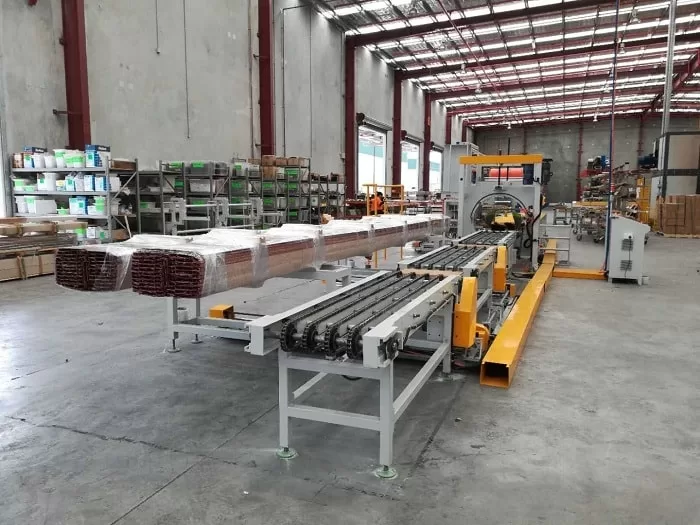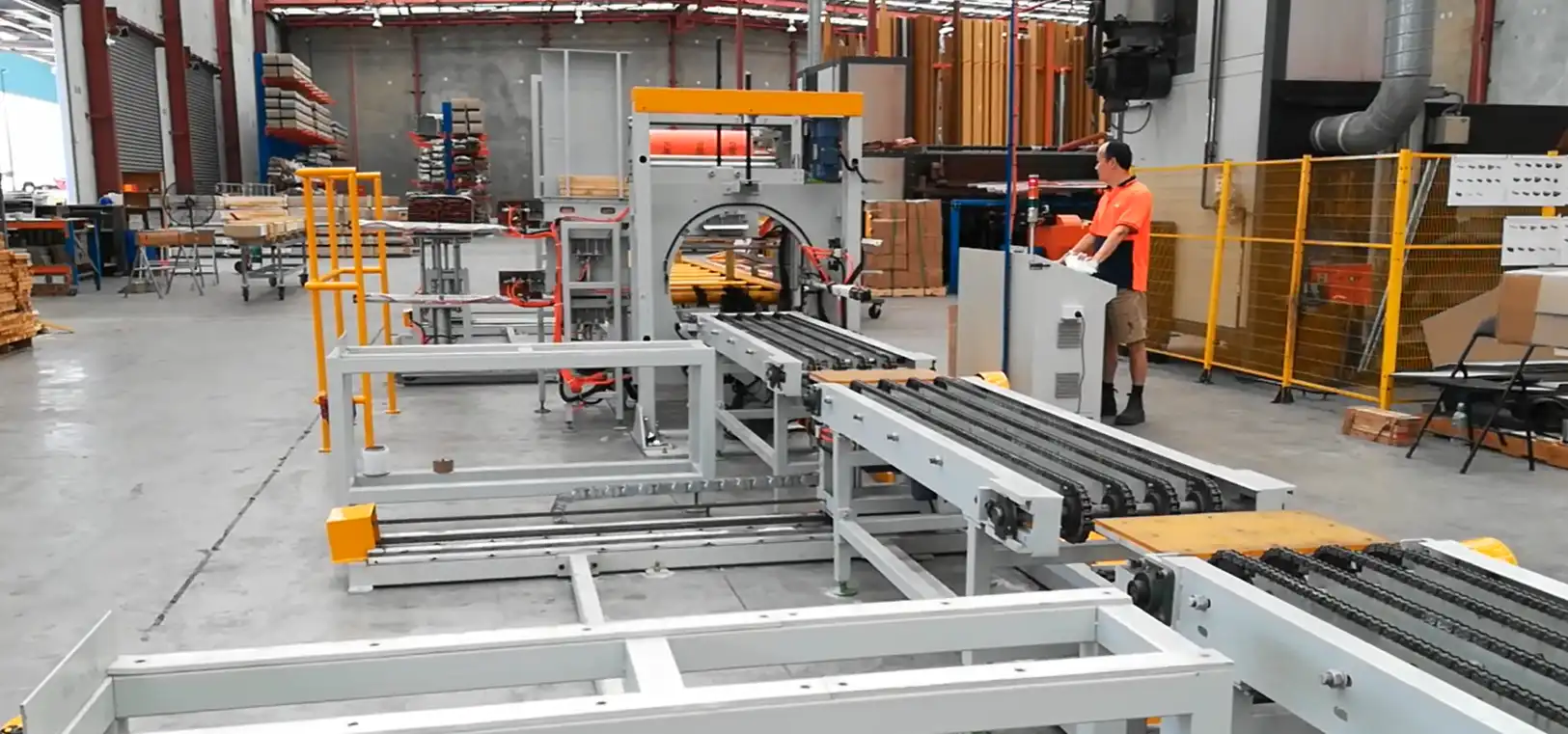Optimizing Aluminum Profile Packaging with Automated Horizontal Stretch Wrapping

Introduction to Modern Aluminum Packaging Needs
In the competitive manufacturing sector, particularly within the aluminum profile industry, efficient and reliable packaging is essential for protecting products during transit and storage. Traditional packaging methods often fall short, presenting significant challenges for manufacturers and distributors, including those operating in regions like Poland. Issues such as inconsistent wrap quality, labor intensity, ergonomic risks, inefficient floor space utilization, high labor costs, and limited throughput are common hurdles. These factors not only affect operational efficiency but also pose challenges to meeting sustainability targets and implementing environmentally conscious policies. Automated packaging solutions, specifically the horizontal orbital stretch wrapper, offer a robust method to address these industry challenges effectively.
Common Challenges in Manual Aluminum Profile Wrapping
Manufacturers handling aluminum profiles frequently encounter difficulties with conventional packaging processes:
- Inconsistent Quality: Manual wrapping can lead to variations in tension and coverage, potentially compromising product protection.
- Labor Intensity & Costs: Manual processes require significant manpower, often involving multiple shifts, leading to high labor costs and potential bottlenecks.
- Worker Strain: The repetitive and physically demanding nature of manual wrapping can cause fatigue and increase the risk of musculoskeletal injuries.
- Operational Inefficiency: Manual methods can result in cluttered workspaces and slower overall production output compared to automated systems.
- Material Waste: Inconsistent application often leads to excessive use of packaging materials like stretch film.
The Role of Automated Horizontal Orbital Stretch Wrappers
The automatic horizontal orbital stretch wrapper provides a technical solution to the aforementioned packaging challenges. By automating the process, this equipment enhances efficiency, standardizes packaging quality, and reduces physical labor demands.
1. Enhanced Consistency and Protection
Automated wrappers apply stretch film with consistent tension and overlap, ensuring uniform packaging quality for every profile bundle, thereby reducing the risk of damage during handling and transport.
2. Continuous Operation Capability
Unlike manual processes limited by worker shifts and endurance, automated systems can operate continuously (24/7), significantly increasing packaging throughput to meet demanding production schedules.
3. Optimized Labor Utilization
Automation allows manufacturers to redeploy workers from manual wrapping tasks to higher-value activities, improving overall labor efficiency and reducing packaging-specific labor costs.
4. Improved Workplace Ergonomics and Organization
Automating the wrapping process minimizes manual handling of long or heavy profiles, reducing physical strain and contributing to a safer, more organized work environment.

5. Support for Sustainability Goals
The precise control over film application minimizes material consumption and waste, aligning with corporate sustainability initiatives and reducing environmental impact.
Technical Specifications and Customization Options
Automatic horizontal stretch wrappers for aluminum profiles are engineered for adaptability. For instance, systems designed for profiles up to 8 meters long, 0.5 meters wide, and 0.5 meters high utilize orbital stretch wrapping for secure containment. Key customizable parameters include:
- Adjustable Wrapping Tension: Control systems allow fine-tuning of film tension based on profile type, bundle configuration, and required load stability, preventing damage to delicate surfaces while ensuring secure packaging.
- Variable Speed Control: Wrapping speed can be adjusted to match production line speed or the complexity of the profile bundle being wrapped.
- Programmable Wrapping Cycles: Specific wrapping patterns can be programmed to provide extra reinforcement at the ends or protect specific areas of the profile bundle.
- Integration Options: Machines can be integrated with infeed and outfeed conveyors, automatic timber feeders for bottom protection, top sheet dispensers, and strapping machines to create fully automated packaging lines.
Industry Application Examples:
- Construction: Ensures long profiles for facades, windows, and doors are securely bundled for transport to job sites.
- Automotive: Provides precise wrapping for aluminum components used in vehicle structures, protecting critical dimensions and surfaces.
- Furniture: Preserves the aesthetic quality of aluminum profiles used in modern furniture during shipping and handling.
- Renewable Energy: Efficiently packages high volumes of aluminum frames for solar panels, supporting the demands of the growing solar industry.
Key Features and Operational Benefits
Modern automatic horizontal stretch wrappers incorporate features designed to meet the needs of aluminum profile manufacturers:
1. Core Machine Features:
* **High Throughput Capacity:** Designed for wrapping speeds significantly faster than manual methods.
* **Precise Tension Control:** Ensures optimal load containment without damaging profiles.
* **User-Friendly HMI:** Intuitive interfaces simplify operation, setup, and troubleshooting.
* **Automatic Film Clamp, Cut, and Seal:** Automates the start and end of the wrapping cycle, reducing operator intervention.
* **Robust Construction:** Built for durability in industrial environments.
* **Safety Features:** Incorporates safety guards, emergency stops, and sensors compliant with relevant standards (e.g., CE).2. Operational Benefits:
* **Time Savings:** Automation dramatically reduces the time required per package.
* **Cost-Effectiveness:** Lower labor needs, reduced material waste, and minimized product damage contribute to lower overall packaging costs.
* **Improved Load Security:** Consistent, tight wrapping enhances protection against shifting, moisture, and contaminants during transit.
* **Enhanced Workplace Safety:** Reduces manual lifting and repetitive motions, lowering injury risks.
* **Consistent Output:** Delivers repeatable, high-quality packaging results regardless of operator variability.
* **Increased Productivity:** Higher throughput enables manufacturers to meet fluctuating demand and deadlines more effectively.
* **Reduced Material Consumption:** Optimized film usage lowers costs and supports sustainability efforts.Illustrative Performance Improvements
While specific results vary, implementing automated wrapping systems often yields significant improvements:
- Throughput Enhancement: Facilities have reported doubling or tripling their packaging output per shift compared to manual methods after installing an automated wrapper.
- Labor Cost Reduction: A common outcome is reducing the number of workers dedicated to packaging shifts, sometimes by as much as 75%, allowing skilled labor to be reassigned.
- Improved Process Control: Automation provides consistent data on cycle times, material usage, and throughput, enabling better production planning, inventory management, and quality control, leading to measurable improvements in overall operational efficiency.
Visualizing the Automated Wrapping Process
Video demonstrating an automatic horizontal stretch wrapper for aluminum profiles.
Observing the machine in operation provides valuable insight:
- Infeed: Aluminum profile bundles are loaded onto the conveyor system.
- Wrapping: The orbital ring applies stretch film efficiently around the bundle.
- Film Management: The system automatically clamps, cuts, and seals the film.
- Outfeed: The securely wrapped bundle moves down the line for storage or shipping.
- Efficiency Comparison: Videos often highlight the speed and consistency advantages over manual wrapping.
Considerations for Implementation
Transitioning to an automated wrapping solution involves several factors:
- Line Integration: Assessing how the wrapper fits into the existing production flow, including conveyor compatibility and space requirements.
- Profile Variation: Ensuring the machine specifications match the range of profile sizes, shapes, and bundle configurations to be handled.
- Operator Training: Providing personnel with adequate training on machine operation, safety procedures, and basic maintenance.
- Maintenance Requirements: Understanding the recommended preventative maintenance schedule to ensure long-term reliability.
- Return on Investment (ROI): Calculating the potential ROI based on projected savings in labor, materials, reduced damage, and increased throughput. Consulting with equipment suppliers can help tailor solutions to specific operational needs.
Frequently Asked Questions (FAQs)
-
Can the automatic horizontal stretch wrapper integrate with our existing conveyor system?
- Most wrappers are designed for integration. A site assessment by the supplier can confirm compatibility and identify any necessary modifications. Standard conveyor heights and communication protocols facilitate integration.
-
What is the typical installation and training timeline?
- Installation usually takes 2-5 days, depending on system complexity and site readiness. Operator and maintenance training typically requires an additional 1-3 days.
-
What maintenance is required for this type of machinery?
- Routine maintenance generally involves daily checks, weekly lubrication of key components, and periodic inspections (e.g., semi-annually) as per the manufacturer's guidelines. Preventative maintenance contracts are often available.
-
Can the machine handle bundles of varying lengths and sizes?
- Yes, these machines are typically designed to handle a specified range of bundle dimensions (length, width, height). Ensure the machine's specifications cover your product range. Custom solutions are often available for non-standard sizes.
-
What warranty is typically provided?
- Warranties vary by manufacturer but often include a 1-2 year period covering parts and labor. Extended warranties may be offered.
-
How soon can we expect a return on investment (ROI)?
- ROI depends on factors like initial investment, production volume, labor rates, and material savings. Many users report significant savings within the first year, with full ROI often achieved within 1-3 years.
-
Does the equipment comply with relevant safety standards?
- Reputable manufacturers design machines to comply with applicable safety regulations, such as CE (Europe) or OSHA (USA). Ensure the supplier provides documentation confirming compliance.
-
What types of stretch film can be used?
- These machines typically work with standard LLDPE (Linear Low-Density Polyethylene) stretch films. The manufacturer will recommend appropriate film types, gauges, and pre-stretch capabilities for optimal performance.